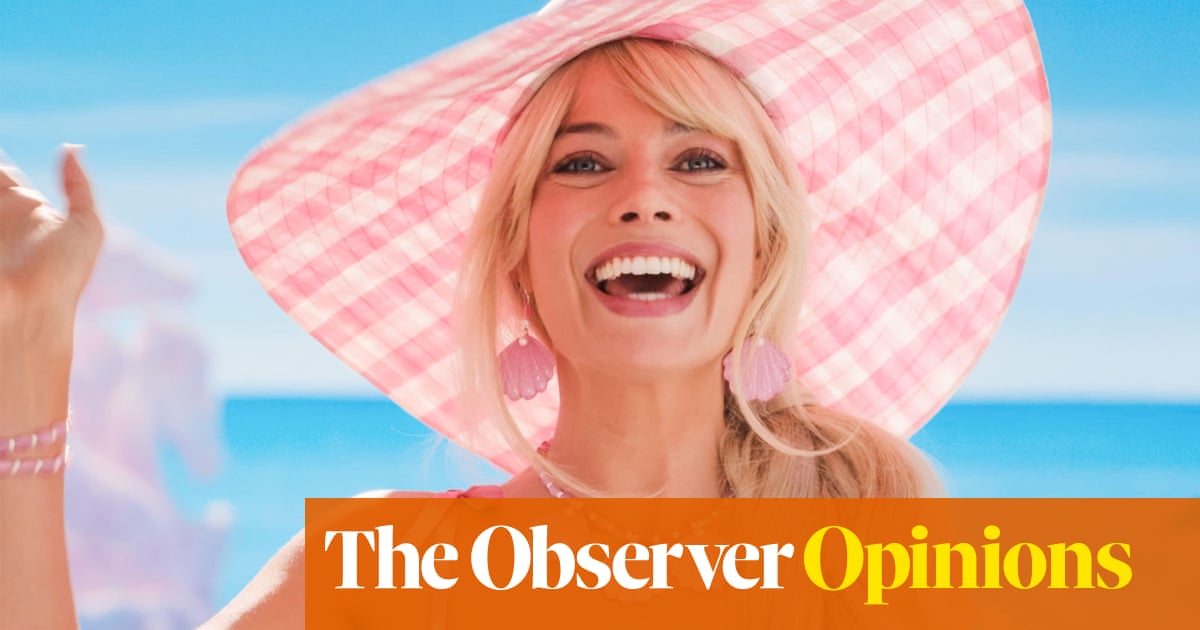
Crazy as this might sound, 10 years ago I honestly thought Barbie was tottering on her tiptoes, ready for a well-earned retirement. A few years earlier, my book, Living Dolls: The Return of Sexism, had energetically questioned why we not only assumed it was natural that girls would love dolls but also why we expected girls to turn themselves into pretty objects in turn.
My questions coincided with growing unease in society with the way the apparently innocuous doll contributed to harsh stereotypes for girls. Barbie made girls less ambitious, psychologists said, or more prone to eating disorders. Sales began to slide; “Barbie slump”, the headlines had it in 2016, or “Barbie out of fashion”.
But just as we started to think it was time for Barbie to be consigned to landfill, the manufacturer, Mattel, gave her a fresh look – or rather, any number of fresh looks. In response to fading enthusiasm for the doll, with her cookie-cutter skinny blonde looks, we’ve had a run of new Barbies. Black Barbies with natural hair, Barbies in wheelchairs, with hearing aids and vitiligo, and all sorts of role model Barbies from Jane Goodall Barbie to Clara Amfo Barbie. And now, with all the glamour that Margot Robbie, Issa Rae and Greta Gerwig can bring to the beach party, Barbie rises yet again. This time, we’re told, she’s empowering. This time, we’re told, she’s actually funny. This time, even if you hate Barbie, you’ll love Barbie.
So the release of the film Barbie has cued a slew of commentators explaining why feminists should learn to stop worrying and love the doll. To an extent, I agree. I never banned the pink plastic ones from my children’s toybox. In fact, Barbies seemed to wander into my daughter’s bedroom of their own accord as gifts and hand me downs from friends and family. As research shows, playing with dolls can stimulate empathy and imagination, and I enjoyed listening to my daughter and her friends chattering away as they took the plastic people on crazy adventures.
So I don’t want to overstate the pernicious influence of Barbie herself. I get that she is just a doll, and most women can take or leave her, play with her or bin her, and might even be inspired by her. Just as it isn’t Instagram alone that fuels narcissism, or the Kardashians alone who enforce unrealistic body expectations, no single brand, model or social media platform should be the target for feminists’ concerns about why inequality and sexism are so damn hard to shift.
But in her own little way, Barbie tells us something about the bigger impasse in which women still find ourselves. The plethora of new, aspirational Barbies, who combine cool jobs with gleaming smiles and shiny hair, serve to remind us just how hard it still is even for successful and experienced women to be valued if they don’t also show doll-like qualities – prettiness, neat wardrobe, perfect shape, youthful faces. In a world in which women are told they can be anything, too often they still have to be dolls as well.
And the reinvention of Barbie shows us all too clearly how the language of women’s empowerment has been taken up on a massive scale not as a means to revolution, but as a tool to unlock further consumerism. The new film has already led to a vast wave of lucrative marketing opportunities for Mattel. “This summer, as well as dressing in Barbie apparel from Gap, Primark or Forever 21, wearing her shoes from Aldo or inline skates from Skatehut and sporting her makeup (NYX Cosmetics and others), you can also relax on a Barbie x Funboy pool float while enjoying Pinkberry’s Barbie-branded frozen yoghurt … play on your pink Xbox and then brush your teeth using ‘the pinkest oral beauty collection ever’, ” ran a Guardian article.
Because Mattel executives now feel they need to speak the language of feminism to sell more effectively to women, they do so energetically. They have reimagined Barbie as “the original girl empowerment brand” and have created something called the Barbie Dream Gap project, to “level the playing field for girls globally by giving them the resources, inspiration and support they need to believe that they can do or be anything”. In practice, it means that a minuscule proportion of Mattel’s profits – in 2022, $250,000 (£190,550) out of $394m, or less than 0.1% – is now put into projects that support girls’ ambitions, such as school workshops or “mentorship conferences”.
This kind of initiative is hardly unique to Mattel. Throughout the business world, executives have learned to speak about aspiration and role models and to remind young women to work on their own confidence and ambition. But while the focus is so firmly on this “dream gap”, all around the world women are still falling into the reality gap. What’s in that gap? Not low aspirations, but low pay, lack of childcare, drudgery, inequality.
To tackle those issues, feminists would need to be able to challenge the excesses and entrenched hierarchies of capitalism rather than embrace them. Mattel’s dedication to using feminist language to sell more and more plastic flotsam to women seems to me to be a poor return on our former dreams of thoroughgoing social change.
I’m not the only one who feels this shift in feminism towards individualism and consumerism as a loss. Living Dolls has just been reissued, and I’ve been struck by some conversations I’ve had with younger readers, who are telling me forcefully that not only do they recognise the problems I mapped out 13 years ago, but they feel that things have only got worse for women and girls. If we still believe girls deserve a freer and more equal world, we need to stop looking to dolls to lead the way forward.












